The pink-necked green pigeon, also known as the rainbow pigeon, has been proclaimed by many to be one of the most beautiful birds in the world, an incredibly impressive feat for a humble pigeon!
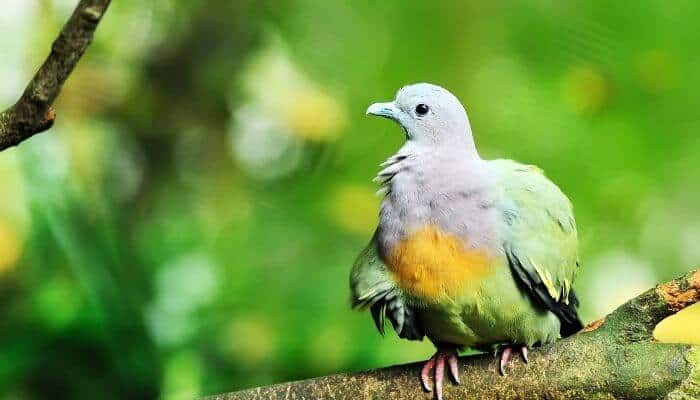
Origins of the Pink-Necked Green Pigeon
When Carl Linnaeus gave this species the name of Columba vernans back in 1771, it’s easy to assume the “ver” was in reference to the green of the pigeon’s coloration, however, he derived vernans from the Latin word vernatis which means brilliant (or flourishing).
The pink-necked green pigeon is a natural species and is native to and incredibly common in Southeast Asia.
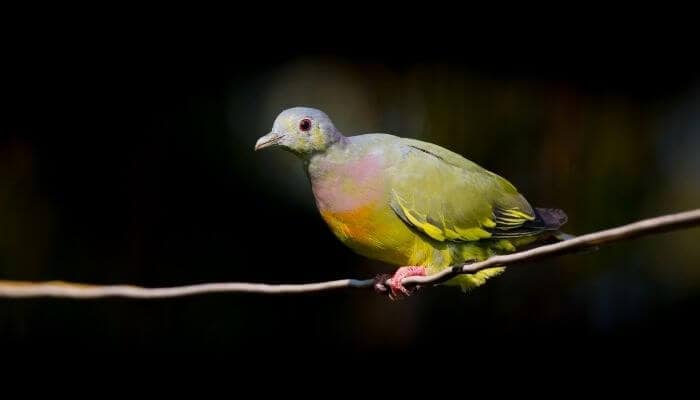
It is related to other pigeons in the “green pigeon” group such as the orange-breasted green pigeon in India.
Nine sub-species have been “identified” but taxonomic status has not been recognised.
These sub-species are listed in the Handbook of the Birds of the World but not in the important checklists for ornithological species, namely the International Ornithological Congress (IOC), The Clements Checklist of Birds of the World and the Howard and Moore Complete Checklist of the Birds of the World.
Pink-Neck Green Pigeon: Distribution And Habitat
The Pink-necked Green Pigeon is widespread in Southeast Asia.
Its range spreads across Myanmar, Thailand, Cambodia, Vietnam, Indonesia, The Philippines and Malaysia.
Although not considered a migratory bird, it is interesting that after the phenomenal volcanic eruption of Krakatoa in 1883, the first bird survey conducted in the remaining islands (in 1908) found the Pink-Necked Green Pigeon was happily at home.
When it comes to preferred habitat, this pigeon is flexible.
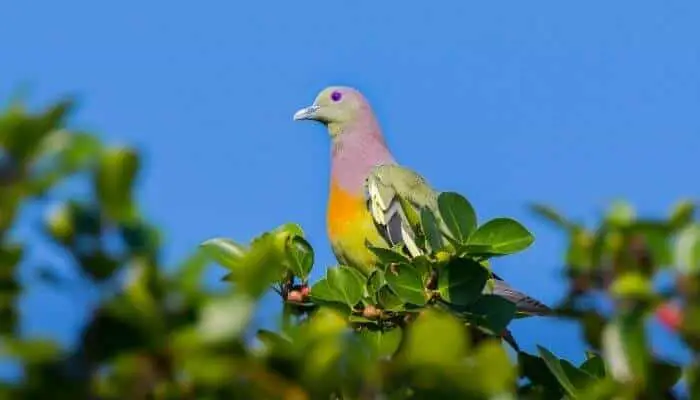
Depending on their location in Southeast Asia, you will find pink-necked green pigeons making homes in primary forest, forest edges, secondary forest and coastal mangroves.
They are happy in lowlands and also at altitudes up to 1,200m (3,900 feet).
The Pink-Necked Green Pigeon favors a more open environment, for example on the edge of a dense forest where they can have the best of both worlds.
You can also find them living in human-dominated areas such as farmland, plantations and gardens, as the species has been noted for being able to adapt really well to urbanization and the presence of people.
You might even find a pink-necked green pigeon in crowded cities providing the cities in question have suitable fruit trees.
The Conservation Status of the Pink-Necked Green Pigeon
Thanks to a currently healthy population, the official conservation status of the Pink-Necked Green Pigeon is of ‘Least Concern’, the lowest possible category that any animal species can be placed in.
This means the species is considered to not be at any risk of extinction however, as we know all too well, these conservation statuses can change in a matter of generations, and we need to keep doing everything that we can to preserve the healthy outlook of the beautiful Pink-Necked Green Pigeon.
Due to its beauty, the species is a target of the illegal cage bird trade.
The Rainbow Pigeon is a favorite prey of White-Bellied Sea-Eagles and raptors like the Peregrine Falcons.
Pink-Neck Green Pigeon Appearance
There is no doubt that the pink-necked green pigeon’s appearance is striking and arresting.
It is a medium-sized pigeon with a plumage that has developed to provide camouflage in the fruiting trees it prefers.
The plumage is a riot of colors, hence the alternate name of Rainbow Pigeon.
It starts with a pale violet/blue-ish head moving down through dusky lavender to its pinkish neck (similar in color to the pale-vented pigeon) to a bright orange breast which then becomes a shade of green which might be lime green or olive or a mix of the two and anything in between.
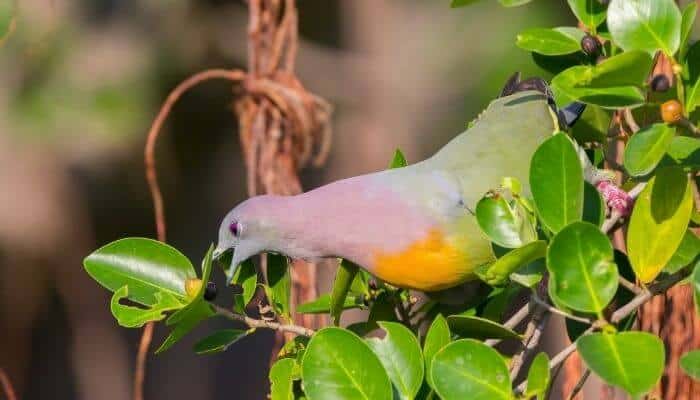
Legs are pale green and end in bright pink feet.
The wings graduate from a slate grey/blue to olive green with indigo accents and yellow edges that form a bar in flight.
The tail picks up the blue/lavender palette with a more grey tone finishing in a black band.
The bird has large magenta eyes and even the beak joins in the colorful act and is an extension of the head color with pale cere.
It should be noted, however, that as is the case with most species across the animal kingdom, this majestic appearance is borne by the male-only. The female is smaller, predominantly green with a yellowish belly.
Typically, the bird measures between 25 and 30 cm (10-12 ins) and weighs 105-160 grams (3.5-5.5 oz).
The Typical Character of the Pink-Necked Green Pigeon
The behavior and temperament of the pink-necked green pigeon is relatively relaxed and chilled.
The species has become very good at adapting to urbanization and human-populated areas and are comfortable in the presence of people and do not scare easily in a crowded city environment.
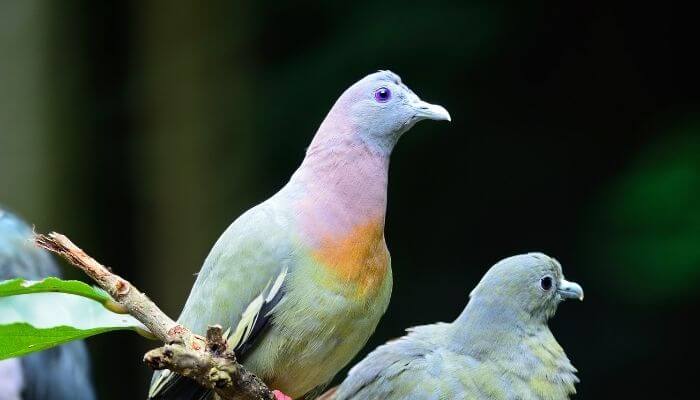
Unlike many other breeds of pigeon, the pink-necked green pigeon is known for not being a very vocal bird.
Cooing is not a common vocalization.
They mostly make a sound like a krrak krrak and quacking and whistling noises although the male does have a tri-syllabic whistle that ends in a coo.
The Diet of the Pink-Necked Green Pigeon
The Pink-Necked Green pigeon is primarily a frugivore – a bird whose main source of food is fruit.
The favorite food of this bird is figs, but they aren’t picky about lots of other types of fruit that they might come across.
Less commonly, they will also eat things like seeds, buds and shoots if their preferred options are not readily available.
The part of the forest where a pink-necked green pigeon is most likely to forage for food is in the mid-canopy rather than the understory or the ground and it is also a social feeder, happy to share a food source in groups of up to 70 in number.
How Pink-Neck Green Pigeons Mate and Breed
The intricate task of nest building is divided by sex.
The male takes on the responsibility of gathering and delivering the best nesting materials, and the female assumes the role of head builder.
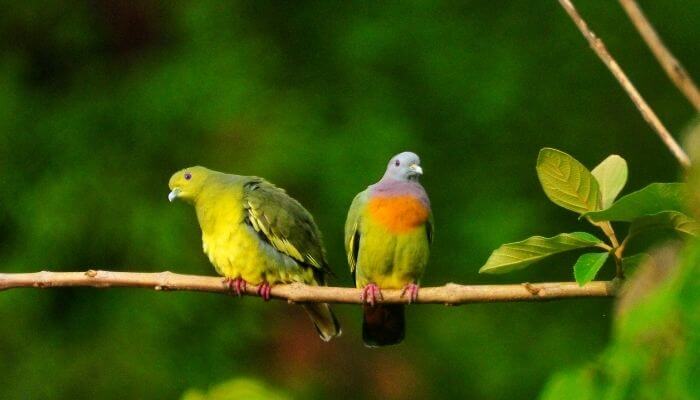
Pink-Necked Green Pigeon nests are simple structures made from twigs and other fibrous vegetation materials.
Nests are usually built 1 to 10 meters above ground level in things like shrubs, hedges and trees.
A clutch is usually two eggs and both parents play a role in raising the chicks from incubation to fledging.
Also Read:
Caring For Pink-Necked Green Pigeons
It is not recommended that you keep a Rainbow Pigeon as a pet.
It is an exotic, tropical bird that at the very least would require a large, outdoor type aviary system with plenty of trees in which to roost and nest. It would be rare to be able to build a pigeon coop that would suit this species.
As we discussed, the diet of a pink-necked green pigeon is nothing like the standard diet of a pigeon which is a seed-based diet, and along we also have to recognize that tropical birds like the pink-necked green pigeon need consistently elevated temperatures to live in, so this will eliminate the chance of ownership for plenty of bird enthusiasts across the world.
Our advice for the pink-necked green pigeon is to admire it from afar, where it can thrive in the wild in its perfect, natural habitat.
Other Interesting Facts About the Pink-Necked Green Pigeon
It’s not every day that a pigeon gets to be one of the biggest trending topics on Twitter, but that is something that the Pink-Necked Green Pigeon can claim!
In March 2021, the species went viral overnight when an unsuspecting user posted a photo of a multi-colored male, expressing their surprise at just how unique and vibrant the pigeon was.
Users soon began to like and retweet the image of what they named the ‘Rainbow Pigeon’, and all of a sudden the wonderful Pink-Necked Green Pigeon was a headliner in the mainstream press.
The original picture post eventually ended up receiving more than four thousand retweets and nearly fifty thousand likes, with many still in disbelief about the cartoon nature of its coloring.
In a world where most animals evolve to blend in with their environments, the Pink-Necked Green Pigeon has certainly decided to move in the opposite direction, and that is certainly an attitude that the internet seems to have fallen in love with!
